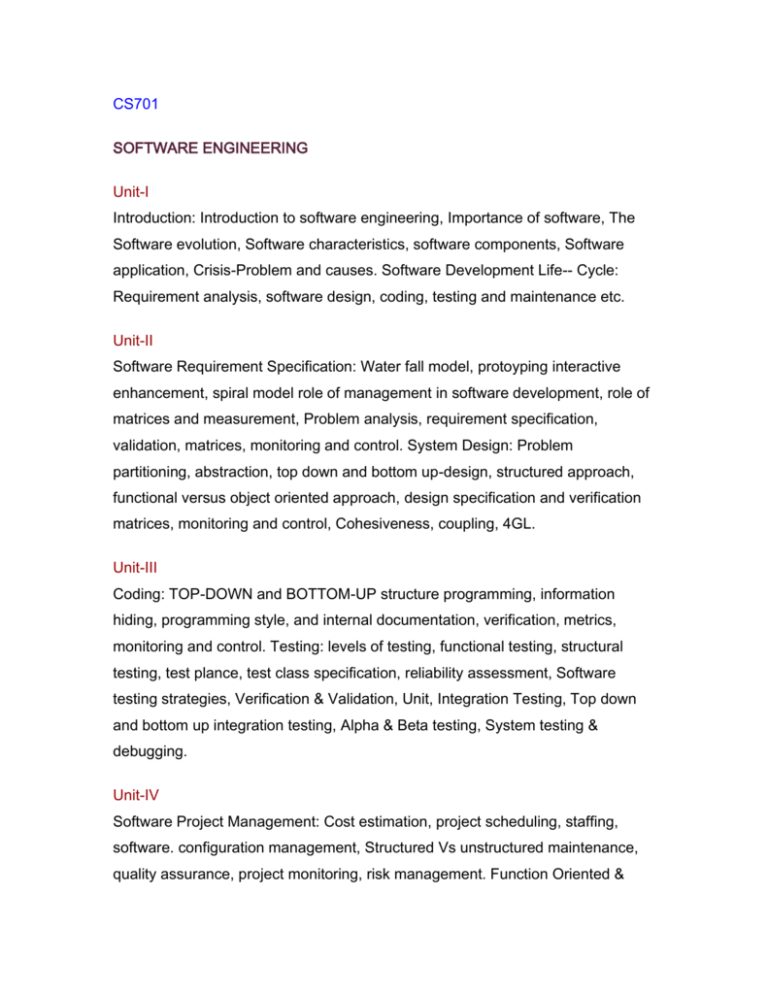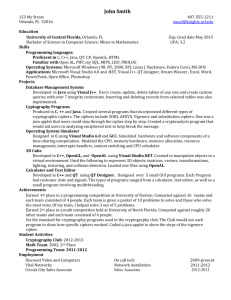CS701
advertisement

CS701 SOFTWARE ENGINEERING Unit-I Introduction: Introduction to software engineering, Importance of software, The Software evolution, Software characteristics, software components, Software application, Crisis-Problem and causes. Software Development Life-- Cycle: Requirement analysis, software design, coding, testing and maintenance etc. Unit-II Software Requirement Specification: Water fall model, protoyping interactive enhancement, spiral model role of management in software development, role of matrices and measurement, Problem analysis, requirement specification, validation, matrices, monitoring and control. System Design: Problem partitioning, abstraction, top down and bottom up-design, structured approach, functional versus object oriented approach, design specification and verification matrices, monitoring and control, Cohesiveness, coupling, 4GL. Unit-III Coding: TOP-DOWN and BOTTOM-UP structure programming, information hiding, programming style, and internal documentation, verification, metrics, monitoring and control. Testing: levels of testing, functional testing, structural testing, test plance, test class specification, reliability assessment, Software testing strategies, Verification & Validation, Unit, Integration Testing, Top down and bottom up integration testing, Alpha & Beta testing, System testing & debugging. Unit-IV Software Project Management: Cost estimation, project scheduling, staffing, software. configuration management, Structured Vs unstructured maintenance, quality assurance, project monitoring, risk management. Function Oriented & Object Oriented Software Design: Overview of SA/SO Methodology, structured analysis, data flow diagrams, extending DFD to real time systems, Object oriented design, Graphical representation of OOD, Generic 00 development paradigm. Unit-V Software Reliability & Quality Assurance: Reliability issues, Reliability metrics, reliability growth modeling, Software quality, ISO 9000certification for software industry, SEI capability maturity model, comparison between ISO & SEI CMM. CASE (Computer Aided Software Engineering) : CASE and its Scope, CASE support in software life cycle, documentation support, project management, external interface Reverse software Engineering, Architecture of CASE environment. References: Pressman r "Software engineering", McGraw Mall R, "Fundamentals of Software Engineering", Prentice Hall Agarwal, Singh "Software Engineering", New Age International Carlo Ghezzi, Mehdi jarayeri, Dino manodrioli," Funadmentals of software engineering", PHI Alexix Leon, mathewsLeon, "Fundamental of software engineering" Vikas Sommerville, "Software Engineering", Addision Wesley. Rumbaugh & Loresson W, "Object Oriented Modeling & Design", PHI 1991 CS702 COMPUTER ARCHITECTURE Unit-I Introduction: Introduction to Parallel Computing, Need for Parallel Computing, Parallel Architectural classification schemes, Flynn's, Shores, Fengs Classification, Performance of Parallel Processors. Amdahl Law Distributed Processing and Quantitative Approach. Unit-II Memory: Processor & Memory hierarchy, bus cache & shared memory introduction to super scalar architectures, Quantitative evaluation of performance gain using memory, cache miss/hits. Unit-III IPipeline Processing: Introduction to Pipeline Processing, SIMD parallel processors, Arithmetic pipelines, steady state analysis of pipeline, Pipelined instruction processing, interlocks, hazards, hazards detentions & resolution memory systems used in pipelines, scheduling of dynamic pipelines. Unit-IV Synchronous Parallel Processing: SIMD Parallel Algorithm, recurrence & matrix computations, Distributed array processor, Processor Arrays, Multiprocessors, parallel programming languages, mapping & scheduling. Unit-V Interconnection Network: Introductions, Elementary Permutations used in Interconnection Network, Network Classification Cross bar network, Commonly used Interconnection Network, Cross bar, Data Manipulator, Network Routing, Multistage Data Manipulator. References: .Peterson & Heresy, "Quantitative approach to computer Architecture", "Morgan Kaufman". Quin, "Parallel computing, Theory & Practices", McGraw Hill Bhujde, "Parallel Computing", New Age International Hwang, "Advance Computer Architecture", McGraw Hill Englander, "Architecture of Computer Hardware & Software System", Jon Willey & Sons CS 703 INTRODUCTION TO WEB TECHNOLOGY Unit-I Introduction: History of web, growth of the web, the past decade, protocols governing the web, web applications, development of the web in India, creating websites for individual and corporate world, introduction to cyber laws of India, international cyber laws. Web Development Strategies: Web projects, writing web project, identification of objects, target users, web team., assessment of web team, team dynamics, planning & process development, early planning, contents, technical & production planning, communication issues. Unit-II Communication with clients, communication breakdowns, development of multidepartmental & large scale sites, quality assurance & testing, study of technological advances and impact of web teams. Design strategies for Ecommerce site developments :- Basic foundation in e-commerce system, creating forms, managing data base through web. Unit -III Java Programming: Introduction, Operator, Data type, Variables, Methods and classes, Multi threaded programming, I/O, Java Applets. Unit-IV Java Library: String Handling, Input / Output exploring Java.io, Networking, Applets classes, Event handling, Introduction to AWT, Working with window, Graphics, AWT controls, Layout manager and Menus, Images, Additional packages. Unit-V Software Development using Java: Java Beans, Java Swing, Java Servlets, Migrating from C++ to java, Application of java, Dynamic Billboard Applet, Image Menu: An image based menu, Lavatron Applets, Scrabblets, JDBC Brief functioning of upper layer E- mail and their applications. References: 1.Sharma & Sharma ,"Developing E-commerce sites",Addison Wesley 2.Burdman , "Collaborative Web Development," Addison Wesley 3.Joel Sklar,"Principle of Web Design ," Vikas & Thomson Learning 4.Horstmall,"Core Java2,vol 1&2",Addison Wesley 5.Kirshnamurthy,"Internet & Java Programming ",New Age 6.Rebelsky,"Exploring Java",Addison Wesley 7.Hervert Schieldt,"The Complete Reference:Java",TMH Open Elective-II CSOO2 HUMAN COMPUTER INTERACTION Unit -I User centered design Of system & interfaces, anatomy and, rational 01 WIMP (Window, Icon, Menus & Pointing Devices) interfaces. Unit -II Dialogue design, Presentation design, user documentation, evaluation! usability testing of user interface. Unit-III Ergonomics and Cognitive issues, hypertext and the World Wide Web. Unit -IV User centered design, human factors in user-centered design,! development & evaluation, Interactive design - rapid prototyping. Unit -V Designing for usability -effectiveness, learnability, flexibility, attitude and usability goals, criteria for acceptability. References: .Sudifte AG , "Human Computer Interface Design" ,2nd ed, Macmillan, 1995 Sheiderman B Desiging the user interface, "Strategies for Effective! Human - Computer Interaction", 2nd ed. Addison Wesley, 1992 Elective-II CSO23 CRYPTOGRAPHY AND NETWORK SECURITY .Unit-I Introduction to Security attacks, services and mechanisms, Introduction to cryptology. Conventional Encryption: Conventional Encryption model, classical encryption techniques - substitution ciphers & transpositions ciphers, cryptanalysis, stereography, stream & block ciphers. Modern Block Ciphers: Block Ciphers principles, Shannon's theory of Confusion and diffusion, fiestal structure, Data Encryption Standards (DES), Strength of DES, Differential & Linear Cryptanalysis of DES, Block Cipher modes of operation, Triple DES, IDEA encryption & decryption, Strength of IDEA, Confidentiality using Conventional Encryption, traffic confidentiality, key distribution, random number generation. Unit-II Introduction to graph, ring and field, Prime and relative prime numbers, modular arithmetic, Fermat's & Euler's Theorem, primality testing, Euclid's Algorithm, Chinese remainder theorem, Discrete logarithms. Principles of public key cryptosystems, RSA algorithm, security of RSA, key management, Diffie-Heilman key exchange algorithm, Introductory idea if Elliptic curve cryptography, Elganal Encryption. Unit - III Message Authentication & Hash functions: Authentication requirements, Authentication functions, Message Authentication codes, Hash functions, Birthday attacks, Security of Hash function & MACS, MD5 message digest algorithm, Secure Hash Algorithm (SHA). Digital Signatures: Digital Signatures, Authentication protocol, Digital Signature Standard (DSS), proof of digital signature algorithm. Unit- IV Authentication Applications: Kerberos & X.509, directory authentication service, Electronic Mail security - Pretty Good Privacy (PGP), S / MIME. Unit-V IP Security: Architecture, Authentication Header, Encapsulating security payloads, Combining security associations, Key management. Web Security: Secure Socket Layer & Transport Layer Security, Secure Electronic Transaction (SET). System Security: Intruders, Viruses and related threads, Firewall design principles, trusted systems. References: William Stallings, "Cryptography and Network Security: Principles and Practice" Prentice Hall, New Jersey. Johannes A. Buchmann, "Introduction to cryptography", SpringerVerlag. Bruce Schiener, "Applied Cryptography".





